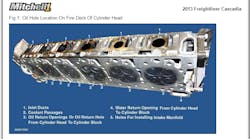MacKay & Company recently had the pleasure of co-sponsoring Heavy Duty Aftermarket Dialogue (HDAD). In addition to presenting the outlook for the trucking economy in 2019, the MacKay & Company team had the chance to chat with many of the other attendees about current and prospective conditions. The HDAD program, which included panel discussions covering industry conditions from several different perspectives ranging from the C-suite to the shop floor that benefited everyone in the audience.
The economic portion of MacKay & Company’s presentation, centered on Truckable Economic Activity (TEA), our proprietary measure of industry conditions, was well-received even though - or perhaps because - it contained a cautionary note about what to expect in 2019.
The presentation described 2019 as being a challenging year for the industry. This is for two reasons.
The first reason is, based on what is known to date, TEA was running at a 5 percent year-over-year pace during the second half of 2018. It will likely be difficult to sustain that pace into 2019.
The second reason was a cluster of issues centering on tariffs, related to the volume of freight and to the use of trucks. Depending on how quickly the several government sources used to analyze these questions get back into regular circulation, the MacKay & Company team will know how much the following has affected the trucking economy.
>Food exports
Food exports, which account for about 10 percent of total exports, surged in the second quarter of 2018. This surge occurred immediately after the Chinese government announced a tariff on U.S. soybeans, as buyers sought to get their goods on the water before the tariff went into effect. Volumes trailed off in the second half of the year. We don’t yet know by how much soybean production might be curtailed in 2019 if farmers think they will be facing a permanent loss of demand.
>Non-automotive consumer goods
Meanwhile, non-automotive consumer goods, which is the technical term for pretty much everything found in a big-box retailer, moved ahead smartly during 2018, paced by rising demand. But tariffs also played a role as retailers sought to get goods, some of which they would have purchased in 2019, into the country before U.S. tariffs went into effect. Several observers have drawn a parallel to the events surrounding Y2K, where pre-buying of computer equipment in 1999 caused a slump in demand in 2000. This, in turn, added to other sources of instability, all of which culminated in the 2001 recession.
>High rate of capacity utilization
Turning to truck use, the rate of capacity utilization was high throughout 2018 even as new vehicles were added to the fleet. The high rate of capacity utilization was also reflected in rising freight rates and a change in the dynamic between shippers and transportation providers.
Shippers began to provide amenities for drivers, as well as assistance in loading and unloading, along with concerted efforts to reduce dwell times in an effort to secure reliable and well-priced service.
>Addressing employee needs
At the same time that transportation companies were enjoying some measure of pricing power, they were also facing cost pressures associated with staffing, training and retaining the employees needed to put trucks on the road and keep them there. The growing use of non-wage compensation such as performance bonuses, tuition reimbursement, special training and expanded fringe benefits were mentioned as ways trucking firms are trying to address their staffing needs.
>Parts distribution
Another hot topic, eCommerce, was especially interesting to watch as an outsider. Parts users had their stories to tell, as did the parts manufacturers and the parts distributors. The only thing they seemed to be able to agree upon was that the parts business today is nothing like the parts business of old. Another aspect of that discussion was the effects of eCommerce on the demand for trucks and truck drivers.
One of the parts distributors told the story of being hit from all sides. He faced competition from the internet on the prices he could charge for parts. He faced competition from the local supermarket for delivery drivers who were being hired to drive for their new eCommerce shopping service. He faced competition for warehouse personnel from a new Amazon distribution center that went up not far from his location, and which was offering starting pay above his current scale.
While 2019 will be challenging year, it will hardly be the first year this industry has been challenged. The participants at HDAD seemed prepared, and even eager, to meet those challenges. We expect you are too.
With a long career managing portfolios and coordinating domestic economic forecasting programs, Bob Dieli began RDLB, Inc. in 2001. In this role, Dieli serves as an advisor to many firms in truck, consulting and financial services sector. He is also an economist with MacKay & Company.




